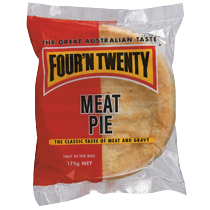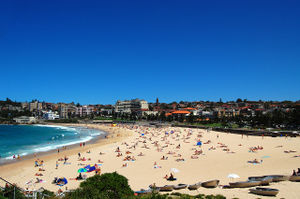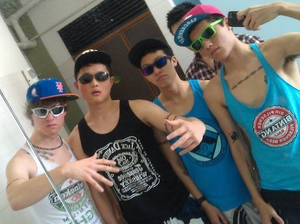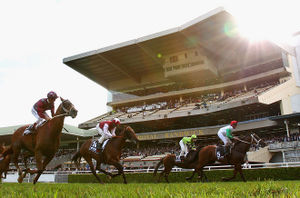Sydney
| Pommies may not understand funny stuff, only humour. Canucks and Yanks may not understand anything at all. Don't change a thing and she'll be right, mate! |
Sydney is the only city in Australia and the single place in the known universe with a bridge.
Through the power of sunbathing-related industry, sunbathing-related trade and sunbathing-related consumption, the city has pulled its way up from lawless penal colony to modern metropolis, all within a period of only two hundred years. Sydney is now host of the headquarters of a number of multi-billion dollar companies, some of which aren't bottle shops, and center of hundreds of square kilometers of suburbs, some of which aren't bottle shops.
Geography[edit | edit source]
The word "Australia" generally evokes thoughts of golden beaches, bronzed locals and dangerous animals that have anything from zero to infinite legs. Nowhere is this mental image more accurate than New South Wales, an Australian state comprised of Sydney city and a wasteland tended to by a handful of farmers in hats.
The borders of the Sydney region are first surrounded by a ring of venomous snakes, whipped into a frenzy by the daily traffic jams on the highways of the rural–urban fringe. These are followed by ravenous dingoes, hungry because the government has never provided anything for regional areas. Finally there is a grove of adorable arts & crafts stores, as you can still find people with taste right up to the Queensland border.
Within this protective cocoon reside the most golden beaches and most heavily bronzed locals the continent has to offer, as well as the most unique harbour and road system the continent has to offer, because whatever the convict urban planners of Sydney were into it definitely wasn't straight or regular.
Urban structure[edit | edit source]
Absolutely everywhere in Sydney has beach frontage and harbour views. If not, it is referred to as Western Sydney. This forms the primary socio-economic division of the city, with Easterners characterized as wealthy and vulgar and Westerners characterized as poor and vulgar.
Visitors to the city may notice the point of transition, as it is where the cafes serving coffee with exotic and impractical kinds of milk (e.g., soy milk, almond milk, hemp milk) give way to the elevated platforms holding rusty V8-powered sedans with no wheels. The division comes up often in real estate ads, with such catchy lines as "You've tried the best, now try the West!" and "Eastern Sydney – spend the vast majority of your time in traffic and destroy your marriage!" however the difference is, ultimately, academic as no one could afford to buy property in either area of the city without having a name that rhymes with Gill Bates.
All areas of Sydney feature abundant park-lands, where adult Sydney-siders organize weekend sporting competitions and then selflessly make schoolkids attend them instead. All areas of Sydney also feature abundant bush-land, where the schoolkids go after being made to attend weekend sporting competitions, usually to drink hemp milk or steal a rusty V8-powered sedan instead.
Demographics[edit | edit source]
As Sydney is now a major center of of the global financial, mining and tramp-stamp industries, there are many migrant residents in the city, who have come for the chance of work and getting punched at Cronulla Beach.
Residents of and visitors to Sydney can easily move between Lebanese, Vietnamese, Chinese, Korean, Italian, Thai and Greek neighborhoods to try the cuisine, buy the clothing, and sample various kinds of ethnic music being played at an offensive volume on car stereos. In turn most, if not all, migrants have gladly adopted the great Australian suburban tradition of constructing houses large enough to have their own currency and then complaining about the cost of living. The spirit of diversity even continues in the inner suburbs of Redfern, Surrey Hills and Darlinghurst, where people of all races and creeds have come together to act like insufferable hipster wankers.
Population, as of the last census:
| Percent | Group | Pie chart |
|---|---|---|
| 76% | Australian born people, who display pride for their heritage by wearing the tank tops of an Indonesian beer brand, Bintang | 
|
| 8% | Englishmen, who have invaded Bondi and killed all the locals. Again. | |
| 6% | Hong Kong Chinese, who enjoy tight black jeans and laughing at mainlanders | |
| 5% | Mainland Chinese, who enjoy tight black jeans and laughing at Hong Kong-ers | |
| 4% | Melanoma growths |
- * 1% margin of error, who have done something really wrong and become a member of parliament
History[edit | edit source]
The first people fortunate enough to claim the Sydney region were the Garigal aboriginal people, who adopted it as a traditional homeland that no one would ever, in a billion years, wish to leave for any reason whatsoever.

Colony[edit | edit source]
In 1788 the Garigal people spontaneously left this promised land, somewhere around the time of the arrival of the British First Fleet in the environs of Botany Bay, although the two events are obviously unrelated.
In actuality the sheltered haven of Sydney Cove a little further up the coast was where the fleet of convicts set about establishing a functional colony. Little hope was held for the creation of a civilized society in the early years, as the various venomous snakes and spiders made this the place in the British realm with the most spiteful original residents, second only to Ireland.
It was therefore a surprise to the Crown when one report identified a steep decline in assaults with a deadly marsupial within Sydney town limits, from 571 in the first year to only two in the third year, and the Crown reasoned that it could only have come as a result of the calming nature of Sydney beachfront life. The first Governor of the colony, Arthur Phillip, noted such in his diaries:
| “ | So multitudinous are the beaches in this Sydney, one can’t help but stumble upon them. This very morn’ I was returning from the privy when I found myself neck deep in the ocean waves with a starfish in my breast pocket and a sea bass in my cod-piece. The beaches may not always be to my taste (as that sea bass was) but the men seem to indulge in them. Sociopathic killer Jack “The Whipper” even saw fit to give up murder for sunbathing, and braided his titular weapon into dreadlocks. As punishment for being too derivative, we hit him with pans instead. | ” |
Keen to expand their rehabilitative penal endeavor, Britain committed to further settlement. For a good three decades, boats would wobble their way across the vast ocean and release on the harbour foreshore a cargo pickpockets and rum, both of which had felt the lips of many an Englishman during their voyage.
Over those years the corrective program exceeded all expectations; Mary Reiby, a convict who cooked and ate the whole congregation of Leeds cathedral, became a prosperous entrepreneur and benefactor of many social initiatives; during construction of Hyde Park barracks absolutely no rapes were recorded, despite being next door to the chloroform distillery and a boarding home for girls; the convicts even planned an end of year meditation holiday to Bali until Governor Macquarie convinced them that the surf at Bronte Beach was superior.
The Sydney area soon flourished into one of Britain's most important agricultural markets, producing numerous different types of plants that could be turned into alcohol and several kinds of livestock that disappointingly couldn't. The port at Darling Harbour became a vibrant trading hub filled with all manner of people speaking a wide array of non-English, and a very limited array of non-inebriated, dialects. Early Sydney-siders were now an easygoing community, but the British elite remained untrustworthy and their cold shoulders ruined a whole summer of sunbathing. The 3rd Earl of Hrrrmmmppphh-shire even campaigned to liquidate the colony, at least until he was killed in a high speed monocle collision.
Federation[edit | edit source]
Thankfully Sydney-siders are a passionate bunch, and almost all dedicated themselves to a grassroots movement of complete indifference and non-action that saw the British finally release their iron grip on the sublime territory and allow it to become a nation. Sydney was even kind enough to invite the other five, more disadvantaged, colonies on the continent into this nation, Australia.
Indeed, the miracle of birth on January 1st, 1901, drew every important world leader of the time to Sydney.
Yes, all one of them.
Queen Victoria was present in a leafy Sydney park to sign Australia into being. So impressed with the city was the Queen, she decided to protect it by banishing the politicians of the Australian parliament to the most dismal place imaginable. Canberra.

20th century[edit | edit source]
In the mid 1910s Sydney-siders fought in their first major conflict, with every suburb losing hundreds of young men in the hellish trenches; but Sydney-siders finally succeeded and drove almost all the poisonous snakes and spiders of the Sydney area into Taronga Zoo.
The harsh economic times of the 1920s and '30s left Sydney industry looking like the arse end of a sick wombat at the aforementioned zoo, so the idea of returning attention to the city's only positive attribute at the time, the harbour, via a 3,770-foot lump of metal cheered people up immensely. Construction on the Sydney Harbour Bridge began in 1923 and was completed in 1932, setting a (then) record of 1457 days without someone accidentally doing work. The bridge joined lush North Sydney with the bustling South and spurred a wave of development which saw the city expand in all directions and subsume some more land that, bizarrely, wasn't beaches.
Impressed by the outcome of their first augmentation to the harbour, Sydney-siders then agreed to the construction of a second, the Opera House. Upon completion Australians were confused by the convoluted operas where people didn't refer to each other with the word mate; however, the finished structure itself was aesthetically impressive and has deprived kangaroos of space on camera memory cards ever since.
To celebrate the resounding success of the bridge and opera house, every New Year Sydney-siders attempt to blow them up with fireworks.
Events[edit | edit source]
Sydney is home to every major Australian sporting event that isn't the Australian Open Tennis Grand Slam, or the Australian F1 Grand Prix, or the most-attended football series in the country, or the most watched horse race in the nation. These include the "City-2-Surf", a half-marathon in which the participants take most of the day off work to wear Lycra™ shorts and sprint from the city to the beach as fast as possible to avoid being photographed in Lycra shorts.
The largest annual festival in the city is a "county fair" that proudly hosts the fattest animals in the country. Sydney-siders turn out to witness the blubbery livestock, and then attempt to outdo the critters at one of the many assembled food trucks. The event is called the Royal Easter Show because crucifixion is slightly less of an ordeal than finding a parking spot.
Finally, during Autumn there is a fantastic march through the city commemorating the bloody military conflict fought over the word poofter, followed by a massive party at the annual gay & lesbian Mardi Gras. The same kind of thing is repeated come Chinese New Year, as the drag queens are replaced with dragons and everyone wakes up with their bowels in a similar state by virtue of the restaurants around Chinatown.
Another special event was the Cronulla peaceful discussion in 2005, in which the iconic bloodbath of true blue aussies beating up the westies was banned from the suburb after it was found by NSW Police to be "dangerous" for some reason.
Economy[edit | edit source]
You mean work? Sydney-siders didn't like the idea and swapped it for another beach.





